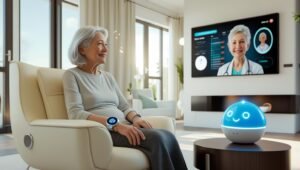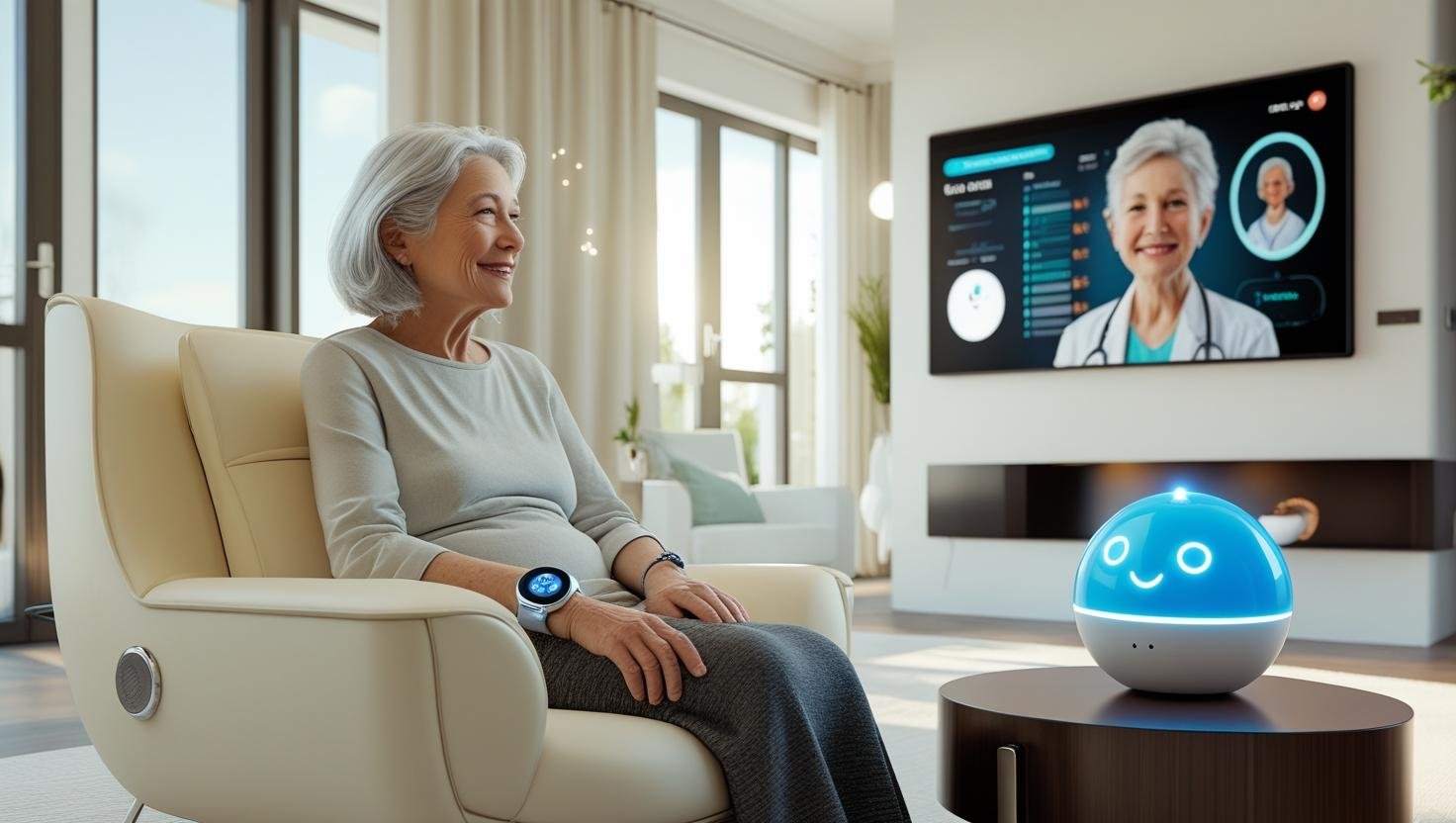How Future Healthcare Technology Is Elevating
The landscape of healthcare is evolving rapidly,How Future Healthcare Technology Is Elevating At‑Home Care and nowhere is this more evident than in the transformation of at-home care. As healthcare systems in the UK and USA face rising costs, aging populations, and increasing demand for personalized services, technology is stepping in to bridge the gap. From AI-powered wearable devices to intelligent virtual care assistants, future healthcare technology is not just an upgrade—it’s a revolution that is enabling people to receive safer, smarter, and more efficient care in their own homes.
This article explores the most promising innovations in at-home healthcare, highlighting benefits, use cases, system-wide impacts, and the challenges that must be addressed to ensure long-term success.

Key Innovations Reshaping At‑Home Care
1. Remote Patient Monitoring (RPM) & Smart Wearables
Remote patient monitoring has become a cornerstone of modern home healthcare. Devices like smartwatches and biosensors now track critical health data—such as heart rate, glucose levels, and blood oxygen—24/7. These tools alert healthcare providers to any abnormal changes, allowing for rapid interventions and preventing complications before they escalate.
AI-integrated platforms enhance this capability by detecting trends, predicting potential health issues, and delivering personalized alerts. Real-world examples from the UK—such as Cera Care—show RPM can cut hospital admissions by over 50% and improve adherence to treatment plans.
2. Telemedicine and Virtual Healthcare Services
The COVID-19 pandemic accelerated the adoption of telehealth across the globe. Today, virtual consultations are widely used to provide medical advice, therapy, and follow-ups from the comfort of home. In both the NHS and US healthcare systems, patients can access GPs, specialists, or physiotherapists through secure video platforms—saving time, money, and travel.How Future Healthcare Technology Is Elevating At‑Home Care
This model is particularly useful for rural residents and patients with limited mobility. It also plays a vital role in chronic disease management by enabling regular digital check-ins.
3. AI-Powered Assistants and Wearable Companions
Conversational AI is finding a unique role in elder care and chronic condition management. In the UK, wearable voice-enabled devices like MICA offer medication reminders, health tracking, and even emotional support. These AI assistants can communicate with caregivers in real time via dashboards, ensuring a higher level of remote oversight.
In the US, platforms such as Joy integrate healthcare and companionship via TV-based systems that support memory games, mental stimulation, and daily routines.How Future Healthcare Technology Is Elevating At‑Home Care
4. Smart Home Integration & Environmental Sensors
Home automation is no longer limited to convenience—it’s now a health tool. Smart lighting systems help prevent nighttime falls, while thermostats maintain optimal living temperatures for patients with respiratory or cardiovascular conditions. Sensors track movement patterns, detect inactivity, and flag potential emergencies like falls or medication noncompliance.
Additionally, smart pill dispensers and air quality monitors help maintain daily health routines with minimal human intervention, promoting safety for individuals with dementia, COPD, or other long-term illnesses.
5. Robotics and Physical Support Systems
Robotic innovations are helping patients regain mobility and independence. Wearable exoskeletons like the Atalante (by Wandercraft) are already assisting paralyzed patients in clinical settings, with plans for home integration supported by Medicare and similar programs.
Elsewhere, pilot programs are exploring humanoid robots that provide hygiene support, basic caregiving, and even emotional engagement for older adults living alone.
6. AI Diagnostics and Personalized Treatment Plans
Artificial intelligence is revolutionizing diagnostics and treatment personalization. Machine learning algorithms analyze data from wearables, medical records, and in-home devices to anticipate health risks and suggest tailored treatments. In the UK, companies like Flok Health have successfully used AI to cut musculoskeletal pain waiting lists by delivering same-day digital physiotherapy plans.How Future Healthcare Technology Is Elevating At‑Home Care
These precision tools not only enhance patient outcomes but also ease the burden on clinicians by automating repetitive diagnostic tasks.
Major Benefits of Future-Ready Home Healthcare
Better Access and Inclusivity
One of the most significant advantages of technology-enhanced home care is increased accessibility. Patients in remote areas, or those unable to travel, benefit from 24/7 connectivity with medical professionals.
Prevention Over Cure
Continuous monitoring enables early detection of potential health issues, helping to avoid emergency room visits and reduce hospital stays. AI-powered alerts and data analytics help caregivers make informed decisions faster.
Enhanced Patient Autonomy
With easy-to-use apps, wearable tech, and voice assistants, patients can manage their own care plans. This sense of control improves mental wellbeing and encourages adherence to treatment protocols.
Financial Efficiency for Patients and Systems
Providing care at home dramatically lowers costs compared to hospital admissions or long-term care facilities. For healthcare systems, this translates into resource optimization and lower operational expenses.How Future Healthcare Technology Is Elevating At‑Home Care
UK and US Case Studies and Emerging Trends
Real-Life Applications
UK: MICA by The ValueCare Group is showing positive results in elder care, allowing personalized voice interactions and real-time health updates.
Flok Health is reducing physiotherapy backlogs through AI-guided home treatment plans.
USA: ONSCREEN’s Joy TV platform is helping seniors stay mentally active, socially engaged, and medically compliant.
Wandercraft Exoskeletons: Now used in clinical trials and preparing for domestic use under insurance programs.
NHS Strategy and Community Integration
The NHS long-term plan places strong emphasis on digitizing care pathways through virtual wards, wearable diagnostics, and remote monitoring. It aims to shift care from hospitals to homes, improving system resilience and community wellbeing.
Challenges to Consider
Protecting Health Data
Patient privacy is paramount. As sensitive medical data moves through cloud systems and apps, strict compliance with GDPR (UK) and HIPAA (USA) is required. Secure platforms and encrypted data flows are essential.
Bridging the Digital Divide
Not all patients—especially older adults—are tech-savvy. User-centered design, training resources, and caregiver support are critical to ensure that all demographics can benefit from digital care solutions.
Ethical Use of AI
Transparency and accountability in AI-driven decisions are crucial. Systems must undergo regular audits to minimize bias and ensure that human oversight remains central to clinical care.
Infrastructure and Funding Gaps
Reliable broadband access, interoperable electronic health records (EHRs), and insurance coverage for home-based diagnostics remain areas requiring government and private sector Palantir Meritocracy Fellowship.
SEO and Voice Search Optimization
Voice search-friendly questions:
“How can I get healthcare at home with new technology?”
